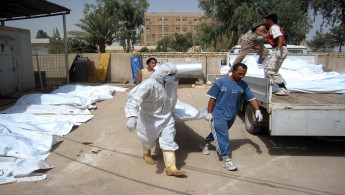Corpses on Iraq’s streets foreshadow a lost generation
Iraq is disintegrating amid sectarian violence, war and political stalemate. One very visible consequence is on the streets, where Iraqis are getting used to the sight of corpses almost carelessly strewn in public spaces, sometimes disfigured beyond recognition.
So widespread is the phenomenon that in some areas it is becoming normalised. Dead bodies in streets have become dinner talk. People talk about them as if they were “talking about a football match”, said Riad Mansour, an official at the Ministry of Industry. “We are used to it. If we don’t see or hear about unidentified corpses for a week, we are surprised.”
Figures are hard to come by. The situation in Iraq is too chaotic, the country too divided, for any central authority to make any accurate count. In one area, Haidar Abd al-Sahib, a police officer, said he had collected 23 corpses in a one-month period. These are left everywhere, he said. “On the side of the road, in front of a shop, in an alley, or in the river. We take turns to collect them and bring them to the morgue.”
| |
"We take turns to collect [corpses] and bring them to the morgue" |
Officials and educators are increasingly worried about what some say is a “culture of killing” gripping the country and the potential effect on children. In addition to having to witness the results of the most grievous violence, children are exposed to bodies that can be so badly disfigured that their identification is impossible. Relatives, said Abd al-Sahib, can sometimes recognise the bodies of their loved ones only “by the clothes they are wearing, scars or birthmarks.”
Many remain unidentified
Teachers have noticed changes in children’s behaviour. Sanaa al-Abadi, an educational supervisor at a Baghdad school, said educators witness more aggression among children who have begun using the “language of death and killing when they talk to each other”.
Abadi said the government needed to pay more attention to the phenomenon. She is advocating for a government rehabilitation programme to counsel children who have witnessed such horrors.
Other say too much damage has already been done. Schoolteacher Abd al-Qader Farman called it a “crisis-in-waiting” for the next generation. “It is inconceivable that this generation can grow up happy and contribute to a culture free of violence and killing after becoming used to the sight of dead bodies.”
| |
"It is inconceivable that this generation can grow up happy and contribute to a culture free of violence and killing after becoming used to the sight of dead bodies" |
But the corpses will continue to show up as long as Iraq’s turmoil persists. Most blame the country’s sectarian divisions that are flaring across Iraq and which show little sign of abating. But the authorities are powerless to confront armed militias.
“We cannot go after these militants because they have more influence and power than we do,” said Abd al-Sahib. “We know we’ll meet a similar fate to the corpses.”
This article is an edited translation from our Arabic edition



